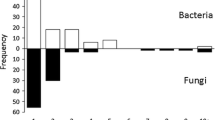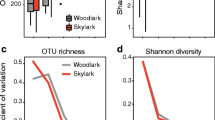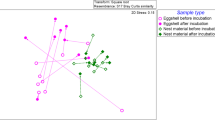Abstract
Although interest in the relationship between birds and microorganisms is increasing, few studies have compared nest microbial assemblages in wild passerines to determine variation within and between species. Culturing microorganisms from blue tit (Cyanistes caeruleus) and great tit (Parus major) nests from the same study site demonstrated diverse microbial communities with 32 bacterial and 13 fungal species being isolated. Dominant bacteria were Pseudomonas fluorescens, Pseudomonas putida, and Staphylococcus hyicus. Also common in the nests were the keratinolytic bacteria Pseudomonas stutzeri and Bacillus subtilis. Dominant fungi were Cladosporium herbarum and Epicoccum purpurascens. Aspergillus flavous, Microsporum gallinae, and Candida albicans (causative agents of avian aspergillosis, favus, and candidiasis, respectively) were present in 30%, 25%, and 10% of nests, respectively. Although there were no differences in nest mass or materials, bacterial (but not fungal) loads were significantly higher in blue tit nests. Microbial species also differed interspecifically. As regards potential pathogens, the prevalence of Enterobacter cloacae was higher in blue tit nests, while Pseudomonas aeruginosa—present in 30% of blue tit nests—was absent from great tit nests. The allergenic fungus Cladosporium cladosporioides was both more prevalent and abundant in great tit nests. Using discriminant function analysis (DFA), nests were classified to avian species with 100% accuracy using the complete microbial community. Partial DFA models were created using a reduced number of variables and compared using Akaike’s information criterion on the basis of model fit and parsimony. The best models classified unknown nests with 72.5–95% accuracy using a small subset of microbes (n = 1–8), which always included Pseudomonas agarici. This suggests that despite substantial intraspecific variation in nest microflora, there are significant interspecific differences—both in terms of individual microbes and the overall microbial community—even when host species are closely related, ecologically similar, sympatric, and construct very similar nests.



Similar content being viewed by others
References
Aguirre AA, Quan TJ, Cook RS, McLean RG (1992) Cloacal flora isolated from wild black-bellied whistling ducks (Dendrocygna autumnalis) in Laguna La Nacha, Mexico. Avian Dis 36:459–462
Akaike H (1974) A new look at the statistical model identification. IEEE Trans Automat Contr 19:716–723
Amann RI, Ludwig W, Schleifer K-H (1995) Phylogenetic identification and in situ detection of individual microbial cells without cultivation. Microbiol Rev 59:143–169
Berger S, Disko R, Gwinner H (2003) Bacteria in starling nests. J Ornithol 144:317–322
Bisson I-A, Marra PP, Burtt EH Jr, Sikaroodi M, Gillevet PM (2007) A molecular comparison of plumage and soil bacteria across biogeographic, ecological, and taxonomic scales. Microb Ecol 54:65–81
Blanco G, Lemus JA, Grange J (2006) Faecal bacteria associated with different diets of wintering red kites: influence of livestock carcass dumps in microflora alteration and pathogen acquisition. J Appl Ecol 43:990–998
Brittingham MC, Temple SA, Duncan RM (1998) A survey of the prevalence of selected bacteria in wild birds. J Wildl Dis 24:299–307
Bruce J, Drysdale EM (1993) Trans-shell transmission. In: Board RG, Fuller R, Board RG, Fuller R (eds) Microbiology of the avian egg. Springer, New York
Burnham KP, Anderson DR (2002) Model selection and multimodel inference: a practice information-theoretic approach. Springer, New York
Burtt EH Jr, Ichida JM (1999) Occurrence of feather-degrading bacilli in the plumage of birds. Auk 166:364–372
Burtt EH Jr, Ichida JM (2004) Gloger’s rule, feather-degrading bacteria, and color variation among song sparrows. Condor 106:681–686
Cafarchia C, Camarda A, Romito D, Campolo M, Quaglia N, Tullio D, Otranto D (2006) Occurrence of yeasts in cloacae of migratory birds. Mycopathologia 161:229–234
Campbell B (1949) Pied flycatchers and nestboxes. Bird Notes 23:224–230
Carter GR (1982) Essentials of veterinary bacteriology and mycology. Michigan State University Press, USA
Cook MI, Beissinger SR, Toranzos G, Rodriguez RA, Arendt WJ (2005) Microbial infection affects egg viability and incubation behavior in a tropical passerine. Behav Ecol 16:30–36
de Hoog GS, Guarro J, Gené J, Figueras MJ (2000) Atlas of clinical fungi, 2nd edn. Centraal Bureau voor Schimmelcultures, Utrecht
Deacon J (2005) Fungal biology, 4th edn. Blackwell, Oxford
Deinhofer M, Pernthaner A (1993) Differenzierung von Staphylokokken aus Schaf-und Ziegenmilchproben [Differentiation of staphylococci from sheep and goat milk samples]. Dtsch Tierärztl Wochenschr 100:234–236 (in German)
Droual R, Bickford AA, Walker RL, Channing SE, McFadden C (1991) Favus in a backyard flock of game chickens. Avian Dis 35:625–630
Field AP (2000) Discovering statistics using SPSS for windows: advanced techniques for beginners. Sage, London
Fischer R, Kües U (2006) Asexual sporulation in mycelial fungi. In: Kües U, Fischer R (eds) The Mycota: growth, differentiation and sexuality, 2nd edn. Springer, New York
Garcia ME, Lanzarot P, Rodas VL, Costas E, Blanco JL (2007) Fungal flora in the trachea of birds from a wildlife rehabilitation centre in Spain. Vet Med 52:464–470
Glunder G (2002) Influence of diet on the occurrence of some bacteria in the intestinal flora of wild and pet birds. Dtsch Tierärztl Wochenschr 109:266–270
Gunderson AR (2008) Feather-degrading bacteria: a new frontier in avian and host–parasite research? Auk 125:972–979
Holt JG, Krieg NR, Sneath PHA, Staley JT, Williams ST (1994) Bergey’s manual of determinative bacteriology, 9th edn. Lippincott Williams and Wilkins, London
Hubálek Z (1978) Coincidence of fungal species associated with birds. Ecology 59:438–442
Hubálek Z (2000) Keratinophilic fungi associated with free-living mammals and birds. In: Kushwaha RKS, Guarro J (eds) Biology of dermatophytes and other keratinophilic fungi. Revista Iberoamericana de Micología, São Paulo, pp 93–103
Janiga M, Sedlárova A, Rigg R, Novotná M (2006) Patterns of prevalence among bacterial communities of alpine accentors (Prunella collaris) in the Tatra Mountains. J Ornithol 148:135–143
Kellogg JA, Bankert DA, Withers GS, Sweimler W, Kiehn TE, Pfyffer GE (2001) Application of the Sherlock mycobacteria identification system using high-performance liquid chromatography in a clinical laboratory. J Clin Microbiol 39:964–970
Kunitsky C, Osterhout G, Sasser M (2006) Identification of microorganisms using fatty acid methyl ester (FAME) analysis and the MIDI Sherlock® Microbial Identification System. In: Miller MJ (ed) Encyclopaedia of rapid microbiological methods, vol. III. Parental Drug Association, Bethesda, pp 1–17
Larone DH (1995) Medically important fungi: a guide to identification, 3rd edn. ASM, Washington
Lombardo MP, Thorpe PA, Cichewicz R, Henshaw M, Millard C, Steen C, Zeller TK (1996) Communities of cloacal bacteria in tree swallow families. Condor 98:167–172
Lucas FS, Heeb P (2005) Environmental factors shape cloacal bacterial assemblages in great tit Parus major and blue tit P. caeruleus nestlings. J Avian Biol 36:510–516
Maul JD, Gandhi JP, Farris JL (2005) Community-level physiological profiles of cloacal microbes in songbirds (Order: Passeriformes): variation due to host species, host diet and habitat. Microb Ecol 50:19–28
McGarigal K, Cushman S, Stafford S (2000) Multivariate statistics for wildlife and ecology research. Springer, New York
Mehmke U, Gerlach H, Kosters J, Hausmann S (1992) The aerobic bacterial flora of songbird nests. Dtsch Tierärztl Wochenschr 99:478–482 (in German)
Mielnichuk N, Lopez SE (2007) Interaction between Epicoccum purpurascens and xylophagous basidiomycetes on wood blocks. Forest Pathol 37:236–242
Mills TK, Lombardo MP, Thorpe PA (1999) Microbial colonization of the cloacae of nestling tree swallows. Auk 116:947–956
Moreno J, Briones V, Merino S, Ballesteros C, Sanz JJ, Tomás G (2003) Beneficial effects of cloacal bacteria on growth and fledging size in nestling pied flycatchers (Ficedula hypoleuca) in Spain. Auk 120:784–790
Nakadate S, Nozawa K, Sato H, Horie H, Fujii Y, Nagai M, Hosoe T, Kawai K, Takashi Y (2008) Antifungal cyclic depsipeptide, eujavanicin a, isolated from Eupenicillium javanicum. J Nat Prod 71:1640–1642
Nuttall P (1997) Viruses, bacteria and fungi of birds. In: Clayton D, Moore J (eds) Host–parasite evolution: general principles and avian models. Oxford University Press, Oxford, pp 271–302
Osterhout GJ, Shull VH, Dick JD (1991) Identification of clinical isolates of Gram-negative nonfermentative bacteria by an automated cellular fatty acid identification system. J Clin Microbiol 29:1822–1830
Palleroni NJ, Kunisawa R, Contopoulou R, Doudoroff M (1973) Nucleic acid homologies in the genus Pseudomonas. Int J Syst Bacteriol 23:333–339
Pendergrass SM (1998) Aerobic bacteria by GC-FAME (method 0801). In: Schlecht PC, O’Connor PF (eds) NIOSH manual of analytical methods, 4th edn. US Government Printing Office, Washington
Petit C, Hossaert-McKey M, Perret P, Blondel J, Lambrechts MM (2002) Blue tits use selected plants and olfaction to maintain an aromatic environment for nestlings. Ecol Lett 5:585–589
Pinowski J, Barkowska M, Kruszewicz AH, Kruszewicz AG (1994) The causes of the mortality of eggs and nestlings of Passer spp. J Biosci 19:441–451
Riffel A, Brandelli A (2006) Keratinolytic bacteria isolated from feather waste. Braz J Microbiol 37:395–399
Ruiz-Rodríguez M, Lucas FS, Heeb P (2009) Differences in intestinal microbiota between avian brood parasites and their hosts. Biol J Linn Soc 96:406–414
Shaw P (2003) Multivariate statistics for the environmental sciences. Hodder Arnold, London
Shawkey MD, Pillai SR, Hill GE (2003) Chemical warfare? Effects of uroygial oil on feather-degrading bacteria. J Avian Biol 34:345–349
Shawkey MD, Mills KL, Dale C, Hill GE (2005) Microbial diversity of wild bird feathers revealed through culture-based and culture-independent techniques. Microb Ecol 50:40–47
Shawkey MD, Pillai SR, Hill GE, Siefferman LM, Roberts SR (2007) Bacteria as an agent for change in structural plumage color: correlational and experimental evidence. Am Nat 169:S112–S121
Silvanose CD, Bailey TA, Naldo JL, Howlett JC (2001) Bacterial flora of the conjunctiva and nasal cavity in normal and diseased captive bustards. Avian Dis 45:447–451
Simon A, Thomas DW, Blondel J, Perret P, Lambrechts MM (2004) Physiological ecology of Mediterranean blue tits (Parus caeruleus L.): effects of ectoparasites (Protocalliphora spp.) and food abundance on metabolic capacity of nestlings. Physiol Biochem Zool 77:492–501
Singleton DR, Harper RG (1998) Bacteria in old house wren nests. J Field Ornithol 69:71–74
St Germain G, Summerbell R (1995) Identifying filamentous fungi: a clinical laboratory handbook. Star, Belmont
Tabachnick BG, Fidel LS (1989) Using multivariate statistics, 2nd edn. HarperCollins, New York
Thompson IP, Bailey MJ, Ellis RJ, Purdy KJ (1993) Subgrouping of bacterial populations by cellular fatty acid composition. FEMS Microbiol Lett 102:75–84
Török J, Tóth L (1999) Asymmetric competition between two tit species: a reciprocal removal experiment. J Anim Ecol 68:338–345
Tortora GJ, Funke BR, Case CL (2007) Microbiology: an introduction, 9th edn. Pearson, London
Tóth EM, Hell É, Kovács G, Borsodi AK, Márialigeti K (2006) Bacteria isolated from the different developmental stages and larval organs of the obligate parasitic fly, Wohlfahrtia magnifica (Diptera: Sarcophagidae). Microb Ecol 51:13–21
Tripet F, Richner H (1997) The coevolutionary potential of a ‘generalist’ parasite, the hen flea Ceratophyllus gallinae. Parasitology 115:419–427
von Graevenitz A, Osterhout G, Dick J (1991) Grouping of some clinically relevant Gram-positive rods by automated fatty acid analysis: diagnostic implications. Acta Pathol Microbiol Immunol Scand 99:147–154
Walker SE, Sander JE, Cline JL, Helton JS (2005) Characterization of Pseudomonas aeruginosa isolates associated with mortality in broiler chicks. Avian Dis 46:1045–1050
Whitaker JM, Cristol DA, Forsyth MH (2005) Prevelence and genetic diversity of Bacillus licheniformis in avian plumage. J Field Ornithol 76:264–270
Whittingham MJ, Stephens PA, Bradbury RB, Freckleton RP (2006) Why do we still use stepwise modelling in ecology and behaviour? J Anim Ecol 75:1182–1189
Wieliczko A, Piasecki T, Dorrestein GM, Adamski A, Mazurkiewicz M (2003) Evaluation of the health status of goshawk chicks (Accipiter gentilis) nesting in Wroclaw vicinity. Bull Vet Inst Pulawy 47:247–257
Wobester GA (1981) Diseases of wild waterfowl. Plenum, New York
Acknowledgments
We thank the RSPB for allowing us to use their reserve as a study site and for the provision of data on avian reproductive success, and Hannah Stubbs for providing invaluable laboratory support. We also thank three anonymous reviewers for their detailed and constructive comments on an earlier draft.
Author information
Authors and Affiliations
Corresponding author
Rights and permissions
About this article
Cite this article
Goodenough, A.E., Stallwood, B. Intraspecific Variation and Interspecific Differences in the Bacterial and Fungal Assemblages of Blue Tit (Cyanistes caeruleus) and Great Tit (Parus major) Nests. Microb Ecol 59, 221–232 (2010). https://doi.org/10.1007/s00248-009-9591-z
Received:
Accepted:
Published:
Issue Date:
DOI: https://doi.org/10.1007/s00248-009-9591-z




